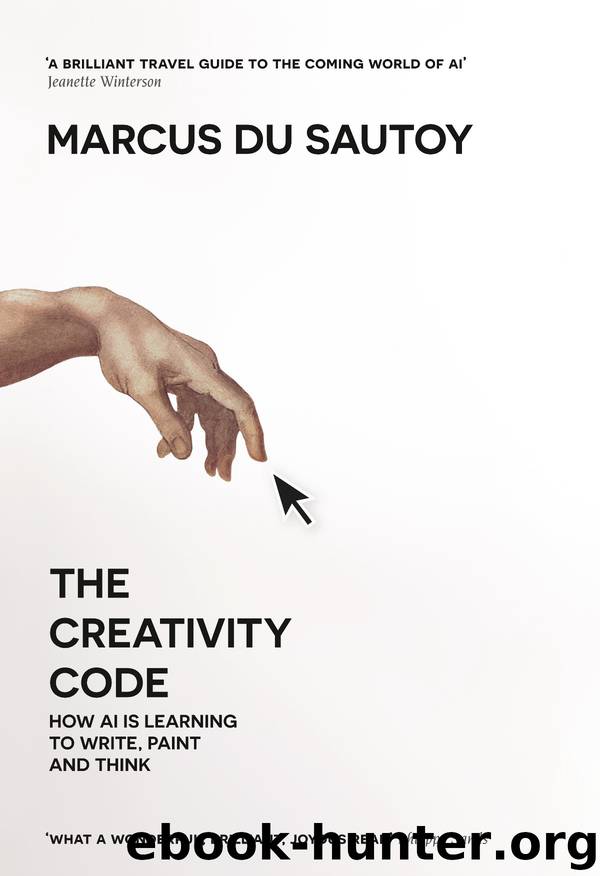The Creativity Code by Marcus Du Sautoy

Author:Marcus Du Sautoy
Language: eng
Format: epub
Publisher: Fourth Estate
Published: 2019-03-07T00:00:00+00:00
10
THE MATHEMATICIAN’S TELESCOPE
Our writing tools participate in the writing of our thoughts.
Friedrich Nietzsche
For all my existential angst about the computer putting me out of the game, I must admit as a tool it has proved invaluable. I can be faced with combining a slew of equations into one single equation. If I tried to do this by hand, I would almost certainly make a mistake. It is a mechanical procedure that requires little thought: you just have to follow a set of rules. This is something my laptop will not bat an eyelid at, and I would trust its calculation each time over my own pen-and-paper attempts. But the role that a computer might play beyond simply manipulating equations has grown over the years.
Given the close bond between mathematics and algorithms, it perhaps isn’t surprising that computers have been partners in proving deep theorems of mathematics for nearly half a century. In the 1970s a computer played a major role in settling the proof of a classic challenge called ‘the Four-Colour Map Problem’. No matter how you redraw the boundaries of the countries in Europe, the problem theorised, you could colour them all using at most four colours in such a way that no two countries with a common border have the same colour. It is impossible to colour all maps with three colours, but four would always suffice.
There was a proof that five colours would suffice, but no one had been able to reduce this to four. Then, in 1976, two mathematicians, Kenneth Appel and Wolfgang Haken, announced that they had found a way to prove why you could always get away with four colours. There was an interesting twist to their proof: they demonstrated that although there are infinitely many possible maps you can draw, there is a way to show that they can all be reduced to an analysis of 1936 maps. But analysing this many maps by hand was going to be impossible – or, to be more accurate, impossible for a human. Appel and Haken managed to program a computer to go through the list of maps and check whether each one passed the four-colour test. It took over 1000 hours for the lumbering computer of the 1970s to run through all the maps.
The computer was not doing anything creative. It was doing dumb donkey work. But could you prove that there wasn’t a bug in the program giving false results? This question of how much we can trust the results of a computer is one that forever dogs the field of AI. As we head into a future dominated by algorithms, ensuring that there are no undetected bugs in the code will increasingly be a challenge.
In 2006 the Annals of Mathematics published a computer-assisted proof of another classic problem in geometry: Kepler’s Conjecture. Thomas Hales, the human behind the proof, had come up with a strategy to prove conclusively that the hexagonal stacking of oranges you see at the grocer’s is the most efficient way to pack spheres.
Download
This site does not store any files on its server. We only index and link to content provided by other sites. Please contact the content providers to delete copyright contents if any and email us, we'll remove relevant links or contents immediately.
| Computer Vision & Pattern Recognition | Expert Systems |
| Intelligence & Semantics | Machine Theory |
| Natural Language Processing | Neural Networks |
Algorithms of the Intelligent Web by Haralambos Marmanis;Dmitry Babenko(16234)
Jquery UI in Action : Master the concepts Of Jquery UI: A Step By Step Approach by ANMOL GOYAL(9386)
Test-Driven Development with Java by Alan Mellor(7735)
Data Augmentation with Python by Duc Haba(7608)
Principles of Data Fabric by Sonia Mezzetta(7378)
Learn Blender Simulations the Right Way by Stephen Pearson(7294)
Microservices with Spring Boot 3 and Spring Cloud by Magnus Larsson(7137)
Hadoop in Practice by Alex Holmes(6587)
RPA Solution Architect's Handbook by Sachin Sahgal(6515)
The Infinite Retina by Robert Scoble Irena Cronin(6215)
Big Data Analysis with Python by Ivan Marin(5933)
Life 3.0: Being Human in the Age of Artificial Intelligence by Tegmark Max(5512)
Pretrain Vision and Large Language Models in Python by Emily Webber(4894)
Infrastructure as Code for Beginners by Russ McKendrick(4652)
Functional Programming in JavaScript by Mantyla Dan(4436)
WordPress Plugin Development Cookbook by Yannick Lefebvre(4382)
The Age of Surveillance Capitalism by Shoshana Zuboff(4243)
Embracing Microservices Design by Ovais Mehboob Ahmed Khan Nabil Siddiqui and Timothy Oleson(4146)
Applied Machine Learning for Healthcare and Life Sciences Using AWS by Ujjwal Ratan(4135)
